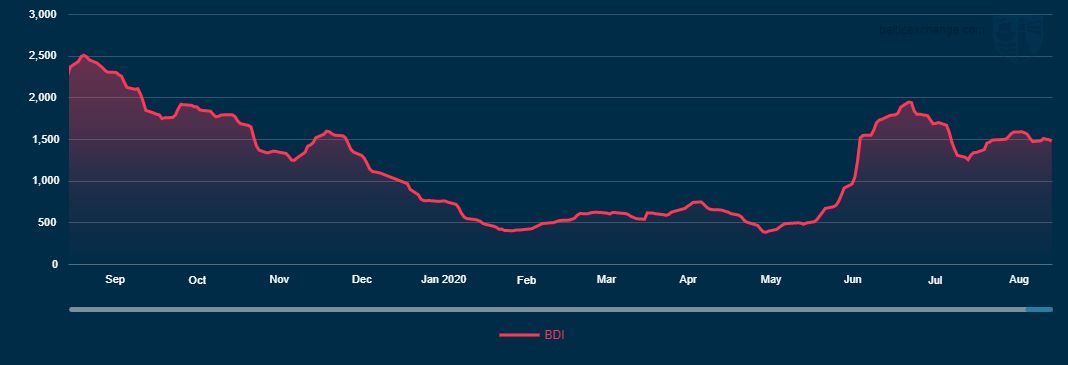BEIJING, Aug.31 (Xinhua) -- The Baltic Exchange has published its weekly report of the dry and tanker markets for August 24-28, 2020 as below:
Capesize
The week ended with a flurry of Brazil fixing which is now hovering in the low $18's – approximately a dollar up on last week. Vale were rumoured to have been active, taking possibly three vessels over 203,000dwt, in the $17.50/17.65 region. Meanwhile there was less activity in the transatlantic market where the C7 and C8 routes came off a shade and the fronthaul was relatively static. The Ocean Cobalt (180,200dwt 2008) which sailed from Mundra on 21 August, was rumoured fixed but no specific details emerged. In the Pacific the benchmark C5 route nudged up around a dollar to $8.11, with talk of Genco tonnage to Rio Tinto around $8.20 and possibly CCL tonnage to FMG at around $8.10 level for 12/14 September. Ore & Metals covered their tender for Saldanha Bay/Qingdao at $13.30 with 1.25 percent total for 13/24 September.
Panamax
US Gulf soya bean exports appeared to come to the fore this week with talk in the news of strong volumes to come for the rest of 2020. Charterers principally opted for decent specification and Neo Panama fitted specification tonnage, altering the dynamic in the Pacific somewhat, and signaling firmer rates and sentiment aided by solid enquiry ex NoPac and Australia. This was highlighted by an 82,000dwt delivery North China achieving $15,250 via US Gulf redelivery Far East. In comparison, it was something of a damp squib in the north Atlantic for most of the week as the Continent tonnage count grew. Despite a varied degree of fixing in places, it did little to quell the softening of rates with P1A and P2A shedding $2,360 and $778 on the week. Second half September and later arrivals ex east coast South America picked up along with seasonal demand from the Black Sea and rates here marked up midweek, but lacked substantial volume overall.
Supramax/Ultramax
The mixed outlook that characterized the Supramax market this week, could not disguise the underlying weakness owing to a heavy prompt tonnage count in some areas, notably the Black Sea and US Gulf. The indices duly reflected, with the relevant fronthaul routes S1B, and S1C losing $964, and $250 respectively on the week. Late on Thursday, an unnamed Ultramax was reported to have fixed a trip from the Black Sea to the Continent at a weaker $11,000 passing Canakkale, whilst the Anatoli (2018 63,467dwt) was linked with Meadway basis delivery retro Damietta for a fronthaul at $25,000 basis min 50 days duration. On a positive, some brokers pointed to increasing tightness from east coast South America for September, with well-described Ultramaxes said to be fixing fronthauls at $15,250 plus $525,000. Any recovery in the short term may well prove to be non-linear.
Handysize
Little signs of improvement from the US Gulf or east coast South America this week, similarly the Pacific. Limited vessels were available in the Continent to make August dates whilst the region, together with Mediterranean/Black Sea market, continued their drive forward with rising trend. A 38,000dwt delivery Dordrecht was fixed for a trip with scrap cargoes to east Mediterranean at $20,000, a strong rate due to shortage of vessels for loading in the Continent with August cancelling. From east coast South America, a 34,000dwt was fixed for a trip to the Continent at $12,000 and the same level was reported on a 38,000dwt for a trip to east coast Mexico. A 32,000dwt delivery South Africa in early September was fixed for a trip to the Continent at $7,500. In the East, a 33,000dwt open Japan was fixed for a run via CIS to back to South Korea at a rate in the mid $6,000s.
VLCC
The Middle East market softened slightly with rates for 270,000mt AG/China losing 2.5 points to settle around WS30.5 and owners are facing continued downward pressure, while the trip for 280,000mt to US Gulf via the cape/cape routing eased about half a point to dip just below WS20. In the Atlantic, the 260,000mt West Africa to China was quieter with only one fixture being reported leading to the market assessment at WS32.5, a drop of five points. In the 270,000mt US Gulf to China market, rates shed $100k to $5.27m.
Suezmax
Rates for 135,000mt Black Sea/Med were again flat hovering around the WS55 level while the market for 130,000mt West Africa/UK Continent slipped slightly to just below WS45. The 140,000mt Middle East Gulf to Mediterranean remained unmoved at about WS19.5
Aframax
In the Mediterranean market, the 80,000mt Ceyhan/Med trade saw rates fall a further six points to WS55. In Northern Europe, rates for 80,000mt Cross-North Sea are seemingly stuck at WS80 and 100,000mt Baltic/UKC also remain at just below mid WS50s. Across the Atlantic the market appears to have bottomed with rates for 70,000mt Carib/US Gulf holding at WS65, and for the 70,000mt US Gulf/UK Continent trip rates are assessed at WS62.5-65 level.
Clean
Owners in the Middle East Gulf had another relatively good week with rates for 75,000mt to Japan gaining six points to mid-high WS90s. In the 55,000mt trade the market has remained static at WS100 level. In the West, a firmer market for 37,000mt UK Continent/USAC saw rates peak at WS150 midweek, however these have since eased and now sit at WS127.5 region, an increase of almost 40 points week-on-week. Conversely, the backhaul business 38,000mt US Gulf/UK Continent has seen rates fall consistently this week with rates losing 30 points to reach a WS90 level. The 38,000mt US Gulf/Brazil market saw a fall of WS25 points to now hover around the mid-low WS130s. The 30,000mt clean cross-Med trade made a gain of about 13 points to WS92.5-95 level, which shows just about a breakeven TCE, basis a round-trip.
Headquartered in London and a subsidiary of the Singapore Exchange (SGX), the Baltic Exchange publishes a range of indices and assessments which provide an accurate and independent benchmark of the cost of transporting commodities and goods by sea. These include the Baltic Dry Index (BDI), the dry bulk shipping industry's best known indicator. Published daily since 1985, this provides a snapshot of the daily spot market earnings of capesize, panamax and supramax vessel types on the world's key trading routes.

Chart shows Baltic Dry Index (BDI) during Aug.29, 2019 to Aug.28, 2020.
In March 2018 the BDI was re-weighted and is published using the following ratios of timecharter assessments: 40 percent capesize, 30 percent panamax and 30 percent supramax. The information is provided by a panel of international shipbrokers.
(Source: The Baltic Exchange, edited by Niu Huizhe with Xinhua Silk Road, niuhuizhe@xinhua.org)




 A single purchase
A single purchase









